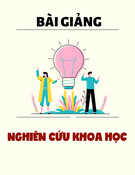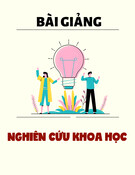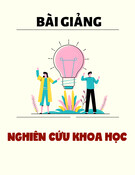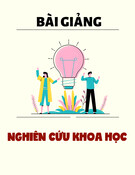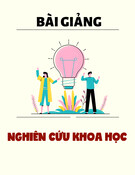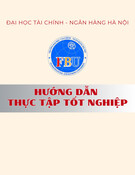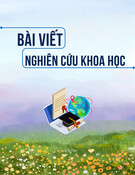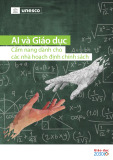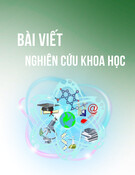
78
HNUE JOURNAL OF SCIENCE
Educational Sciences 2024, Volume 69, Issue 4, pp. 78-86
This paper is available online at https://hnuejs.edu.vn
DOI: 10.18173/2354-1075.2024-0165
STRATEGIES FOR ORGANIZING PRACTICAL LESSONS IN TEACHING
GRADE 11 VIETNAMESE HISTORY AT VINSCHOOL HIGH SCHOOL, HANOI
Nguyen Thi Bich
Faculty of History, Hanoi National University of Education, Hanoi city, Vietnam
Corresponding author Nguyen Thi Bich, e-mail: bichnt@hnue.edu.vn
Received September 10, 2024. Revised September 27, 2024. Accepted September 30, 2024.
Abstract. This article proposes several measures to organize practical lessons, a new type of
lesson introduced in the 2022 History General Education Program. The study is based on
feedback from 28 teachers and observations of 240 grade 11 students at Vinschool High
School, Hanoi, who participated in these practical history lessons. The results indicate that
effective organization of practical lessons requires an emphasis on group discussions, role-
playing, and field trips, enabling students to gain a deeper understanding of historical events,
while fostering critical thinking and teamwork skills. Additionally, special attention should
be paid to lesson planning, integrating information technology, and creating a positive
learning environment. The proposed measures for organizing practical lessons at Vinschool
Hanoi High School not only enhance the quality of history teaching but also contribute to the
comprehensive development of student's abilities.
Keywords: practical lesson organization, high school, Vietnamese history topics.
1. Introduction
Vietnam’s 2018 General Education Program [1] and the revised High School History
Program outlined in Circular 13 in 2022 [2] introduce practical lessons as a new lesson type.
According to the Vietnamese Dictionary [3] “practical activity” refers to applying theory to
practice. In this context, students engage in activities where they apply their acquired knowledge,
skills, and methods to real-world tasks, showcasing their capacities and personal qualities. The
2018 general education program identifies practical activity as one of three primary learning
activities (practice, problem discovery, and training). In history, practice refers to applying
learned knowledge to acquire new insights and complete socially meaningful tasks, such as
contributing to local history research, building traditional houses, disseminating historical
knowledge, or maintaining martyrs' cemeteries [4].
The integration of study and practice is a key focus of numerous educators, including M.B.
Korokova and Studennikin [5], as well as Vietnamese researchers such as Nguyen Thi Coi, Trinh
Dinh Tung, Lai Duc Thu, and others [6-10]. These studies emphasize the importance of practical
activities in history education. In the 2018 General Education Program, practical lessons account
for 20% of the curriculum. Several articles have addressed organizing experiential activities in
history to meet the goals of the 2018 program [12-14], yet most focus on lesson planning rather
than detailing specific types of historical practice exercises.
Unlike the 2006 Program, where practical activities were extracurricular, the 2022 General
Education Program considers practical lessons an integral component of classroom instruction.

Strategies for organizing practical lessons in teaching Grade 11 Vietnamese History at…
79
These lessons aim to consolidate and deepen students' understanding, promote the development
of subject-specific skills, and increase engagement in history. They can be organized during class
time or as experiential activities, such as history competitions, games, or clubs like the “I Love
History” Club... Based on the characteristics of historical knowledge, two main types of practical
lessons can be distinguished: 1) Lessons that consolidate and clarify knowledge, structured
around cognitive exercises, event sequencing, and mind mapping to help students solidify their
understanding. The limitation of this approach is its failure to engage deeply with core content.
2) Lessons that delve into the core content of historical topics, fostering deeper knowledge and
understanding. Both lesson types enhance teachers’ pedagogical skills, encourage creativity, and
constantly improve teaching methods. These practical lessons bridge the gap between history and
real life, making learning more meaningful and motivating for students. At Vinschool High
School in Hanoi, part of the Vinschool Education System, practical lessons play a vital role in
nurturing proactive learning habits, enhancing students' love for history, and preparing them for
success in both academic and personal endeavors.
2. Content
2.1. Research method
This study employed quantitative methods, collecting data from 28 teachers and 240 grade
11 students in the Vinschool system during the 2023-2024 school year. The focus was on teaching
practical lessons on Vietnamese History topics for grade 11. The research questions were: 1) What
measures can be applied to organize practical history lessons to develop students' abilities
comprehensively? 2) What are students' responses to these measures for organizing practical
history lessons at Vinschool High School?
2.2. Analysis of survey results
The survey results show that teachers clearly understand practical lessons, the different types
of practical lessons being implemented, and how to effectively organize them. History teachers
in the Vinschool system are enthusiastic, responsible, and professionally competent. They apply
various methods and techniques in teaching, fostering a proactive, engaged, and enjoyable
learning environment for students. Under the 2022 History Program, and with the support of the
school's modern facilities, the History teachers at Vinschool High School have aligned with the
Curriculum Mapping project and specific requirements of Vinschool. The expected outcome for
students is that they will possess knowledge, learning skills, critical thinking, and leadership
abilities, along with strong personal qualities, equipping them to be global citizens while retaining
a strong sense of Vietnamese cultural identity and national pride.
Feedback from the 240 students regarding their practical lessons shows strong enthusiasm
and engagement with historical practical activities. Students actively participate in experiential
and extracurricular activities (once per semester), learning projects, specialized exercises, and in-
class practical content related to new knowledge or specific practical lessons for each topic.
Students are highly proactive and confident in expressing their opinions, particularly in
developing critical thinking and effectively using information technology through lessons
applying BYOD (Bring Your Own Device). The survey revealed high levels of interest in both
History as a subject and practical lessons, demonstrating that Vinschool students are actively
developing historical skills and drawing lessons from the past for the present and future.
However, the survey also revealed challenges for teachers in choosing practical lessons and
organizing practical activities. Teachers have not fully incorporated group activities to encourage
cooperative learning and maximize students' abilities. The results highlight the need for more

Nguyen TB
80
active participation in practical activities, especially in history lessons. Based on these findings,
we propose several measures for organizing practical history lessons.
2.3. Discussion and Proposal of Measures for Organizing Practical Lessons in
Teaching Vietnamese History to Grade 11 Students at Vinschools High School
The Vietnamese History section in the 11th-grade History Program covers three main topics:
4) The wars to defend the Fatherland and liberate the nation in Vietnamese history (before the
August Revolution in 1945). 5) Significant reforms in Vietnamese history (before 1858). 6) The
history of protecting Vietnam's sovereignty, rights, and legitimate interests in the East Sea. At
Vinschool Hanoi High School, the History program has been revised based on the national
standard curriculum. The revised program allocates 20 periods for new content and five periods
for practice, which is one more practice period than the national standard.
2.3.1. Organizing practical lessons during in-class hours
* Organize practical lessons in the form of historical games
Learning games, which combine fun with teaching elements, are an effective method for
deepening, enriching, and bringing history lessons to life. Organizing historical games follows
these steps: 1) Task assignment (determining goals and planning), 2) Preparation (gathering
information), 3) Game participation (explaining rules, playing, and declaring winners), and 4)
Reflection and evaluation (discussing key takeaways, assessing the game’s significance, and
recognizing outstanding students).
For topic 6, two practical lessons are organized through a gameshow titled “Fatherland Seen
from the Sea”, the warm-up activity involves listening to the song “Fatherland Calls My Name”
and identifying key historical topics. The gameshow consists of three stages: Stage 1. Sovereignty
Marks: Students answer ten questions about Vietnam's establishment of sovereignty over the
Hoang Sa and Truong Sa archipelagos. Stage 2. Sea and Islands at the Edge of the Waves: Using
electronic devices, students participate in a quiz about Vietnam's efforts to protect its sovereignty.
Stage 3. Vietnam at the International Negotiation Table: Students present and debate topics
related to Vietnam's sovereignty and peaceful resolution of disputes in the East Sea.
After the gameshow, students reflect on their experiences, the knowledge, and skills applied,
and suggest additional practical activities for future topics. This format effectively consolidates
students’ knowledge and develops critical thinking, problem-solving, and independent learning
skills, while fostering patriotism and responsibility.
* Organize practical lessons using the debate/argumentation method (debate)
Debate is a powerful method for encouraging student engagement, critical thinking, and the
exploration of multiple perspectives. In history lessons, debates can focus on characters or events,
allowing students to present, defend, and challenge different viewpoints. For example, in topic 5,
students could debate the contributions of figures like Ho Quy Ly, Le Thanh Tong, and Minh
Mang. The process involves Step 1. Transfer of Debate Practice Tasks: Students evaluate the
contributions or limitations of historical figures and participate in a debate based on two prompts.
Step 2. Conduct the debate task: Students organize their arguments and evidence. Step 3.
Participate in debate practice: Groups support or oppose their assigned viewpoints. Step 4.
Feedback, Evaluation, and Summary Post-Debate Practice: Students reflect on the debate,
summarize key points, and apply lessons for future debates.
Organizing practical lessons using the debate method stimulates students to think actively to
find arguments, reasons, and evidence for their points of view while practicing the skill of
listening to different opinions from many sides. From there, develop the ability to look at an issue
from many aspects, and have a sense of respect and calmness towards opposing opinions.

Strategies for organizing practical lessons in teaching Grade 11 Vietnamese History at…
81
2.3.2. Organize practical lessons outside the classroom
* Organize practical lessons to guide students in designing learning products
Guiding students in designing learning products during practical lessons can involve both
handmade products, such as models and comics, and technology-based products, such as posters,
graphic novels, videos, historical cartoons, and infographics. Students can utilize various tools
and software, combining text and images to develop products that foster digital citizenship skills.
These lessons help students consolidate their knowledge, develop observation, thinking, and
creativity skills, and actively engage with the subject. They also allow students to create their own
products, either individually or in groups, fostering passion and interest in the subject, enhancing
student capacity, and achieving the educational goal of “learning by doing”. The process of
organizing a practical lesson on designing learning products for Topic 4, is as follows: Step 1.
Assign the task of designing learning products: The lesson focuses on the Lam Son uprising and
the Tay Son movement, with students assigned to the following groups: Group 1: Handicraft
models; Group 2: Historical comics; Group 3: Graphic design; Group 4: Historical cartoons.
Teachers provide rubrics for evaluating the products. Step 2. Execute the task of designing
learning products: Students work in groups, develop ideas, assign tasks among members, and
regularly report progress. Step 3. Reporting on the Designed Practical Products: Each group
presents its product at different corners of the classroom, with members taking turns to report,
while the other students listen, ask questions, and offer feedback. Step 4. Comments, Evaluation,
and Summary After Practicing Learning Product Design: Based on rubrics, teachers provide
feedback, summarize the lesson, and draw conclusions from the students’ designed products.
Guiding students in designing learning products not only improves teachers' teaching
capacity but also maximizes learners' abilities and qualities.
* Organize practical lessons in the form of scientific research clubs
Creating scientific research clubs for history allows students who share a common interest
in exploring historical events, figures, and issues to engage in research. This method is an
effective way to develop historical knowledge, critical thinking, and the ability to apply
knowledge and skills to real-world problems, enhancing students' historical practice skills.
Organizing history practice lessons through scientific research clubs helps promote dynamism,
creativity, independent thinking, and self-learning. However, this form of lesson organization is
more suitable for students who have the interest and motivation to engage deeply in history.
Topics should be chosen flexibly to stimulate curiosity and investigative thinking.
For instance, after finishing Topic 6, the research process might proceed as follows:
Step 1. Transferring the Research Task: The objective is to study how Vietnam established
sovereignty over the Hoang Sa and Truong Sa archipelagos. Students are assigned research
methods and guided through the process of gathering theoretical and practical evidence.
Table 1. Implementation plan for the scientific research project: 'The Process of Vietnam
Establishing Sovereignty and Management Over the Hoang Sa and Truong Sa Archipelagos
Research stage
Percentage
point
Products to be submitted
Research
orientation
10%
+ Research questions for the topic
+ Justification for choosing the research question
+ Adjusting the scope of the research question
Information
Collection
20%
+ List of potential sources
+ Evaluate sources
+ Record the relevance of the source to the research question

Nguyen TB
82
Synthesize ideas
to develop
research paper
20%
+ List of sources
+ Outline of research question, including synthesis of content
from sources
+ Note the relevance of sources to research question
Complete the
first research
paper
30%
+ Outline for research question (edited)
+ First complete paper
Complete the
second research
paper
20%
+ Editing and proofreading checklist for the article
+ Second completed article after being evaluated according to
the requirements of the editing and proofreading checklist
Step 2. Conducting Research: following the five stages outlined in the table below.
Table 2. Contents of the completed scientific research project titled 'The Process of Vietnam
Establishing Sovereignty and Management over the Hoang Sa and Truong Sa Archipelagos
Research
stage
Products to
be
submitted
Student Activities
Research
orientation
+ Research
questions for
the topic
+
Justification
for choosing
the research
question
+ Adjusting
the scope of
the research
question
+ Discuss and develop research questions: Before 1884, how did
Vietnam establish sovereignty and continuous state management
of the Hoang Sa and Truong Sa archipelagos?
+ Student group representatives report on the research questions
their group proposed (Clearly state the reasons for choosing the
question). => After receiving comments and feedback from
teachers. Students can adjust the scope of the research question.
For example: Shortened the time scope under the reigns of King
Gia Long and King Minh Mang.
+ Discuss and provide answers to research questions,
and propose research hypotheses.
+ Determine and complete the name of the research topic.
+ Assign tasks: time, tasks, assigned people, means, expected
results…
Information
Collection
+ List of
potential
sources
+ Evaluate
sources
+ Record the
relevance of
the source to
the research
question
+ Collect relevant information (documents, pictures, videos
from sources):
1. Complete map of Dai Nam nhat thong (1838)
2. Nguyen Dynasty's royal records
3. Nguyen Dynasty's king's order
4. Dai Nam thuc luc of the National History Institute of Nguyen
Dynasty
5. Internet documents...
+ Evaluate the sources:
The Complete Map of Dai Nam nhat thong (1838) is a reliable
original document, assigned by King Minh Mang to the Imperial
Guard to be in charge of mapping.

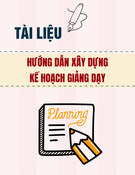








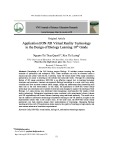
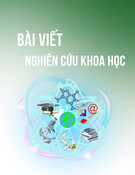
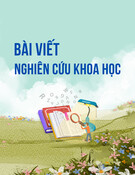
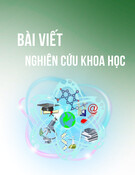

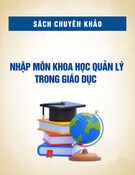
![Định hướng giáo dục STEM trong trường trung học: Tài liệu [chuẩn/mới nhất]](https://cdn.tailieu.vn/images/document/thumbnail/2025/20251124/dbui65015@gmail.com/135x160/25561764038505.jpg)
